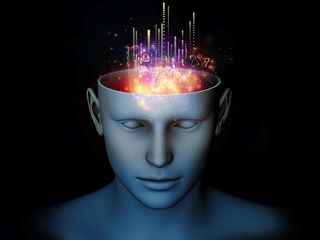
New 'Consciousness Meter' Could Aid Brain-Injury Treatments

A new technique that can determine a person's level of consciousness could benefit patients who have suffered brain damage. These patients range from those who are fully aware but are unable to respond — known as "locked-in syndrome" — to those in a vegetative state, oblivious to the world.
The technique, which entails sending a magnetic pulse across the brain and measuring the brain's response to it, has the potential to measure consciousness even when the patient cannot reply to other stimuli, such as light, sound or hand squeezing.
The scientists involved in the development of this technique caution that it shouldn't be used to determine whether to "pull the plug" on someone in a vegetative state. Rather, they said, the technique could be used to monitor a patient's day-to-day recovery following a brain injury, and to determine whether the patient is thinking or feeling anything.
A description of the technique, called the Perturbational Complexity Index (PCI), appears today (Aug. 14) in the journal Science Translational Medicine.
Is there anybody in there?
The nature of consciousness has long been elusive, debated by scientists and philosophers alike. People routinely enter an unconscious state when they're in a deep sleep or under anesthesia, but ultimately, they awaken.
Yet a person's appearance does not always yield clues to their consciousness — those who have suffered severe brain injuries may be fully conscious, or awake, yet they simply appear unconscious due to their inability to move or respond to stimuli. Conversely, those in a vegetative state can perceive nothing of the world around them, yet they might appear conscious, occasionally moving, grimacing and even groaning. [10 Ways to Keep Your Mind Sharp ]
Sign up for the Live Science daily newsletter now
Get the world’s most fascinating discoveries delivered straight to your inbox.
The new research, led by Dr. Marcello Massimini at the University of Milan in Italy, started with the theoretical idea that consciousness depends on the brain's ability to coordinate information across interacting regions. A magnetic pulse sent through these regions should stimulate the brain, and produce a specific activity pattern that could be measured by electroencephalography (EEG).
Earlier work by these researchers showed a pulse in a conscious brain produced a rich, full EEG signal across the entire brain. In contrast, a pulse in an unconscious brain, in deep sleep or under anesthesia, produced a shorter, stunted EEG signal.
To sleep, perchance to dream
The new study expanded this test to 52 people in various states of consciousness and unconsciousness: wakefulness, a light stage of sleep called dream sleep, deep sleep, sedation induced by different types of anesthesia, a coma-induced minimally conscious state, locked-in syndrome and a vegetative state (now called "unresponsive wakefulness syndrome").
The PCI could differentiate among all of these states. The index, based on a complicated mathematical analysis of the EEG, rates people's level of consciousness on a scale from 0 to 1. Fully awake patients in the study had a PCI of 0.6 or higher, patients in a dreaming (light) sleep had a PCI of about 0.4 and patients in a deep sleep had a PCI of about 0.2.
Those who were anesthetized had PCIs as low as 0.12, which means they were in a deep state of unconsciousness. The more potent the anesthesia, the lower the PCI.
Among patients with brain damage, those thought to be in a vegetative state had PCIs similar to people deeply under anesthesia. The patients suffering from locked-in syndrome were wide-awake, with PCIs of about 0.6, and those in a minimally conscious state had PCIs of about 0.3.
A PCI value higher than the anesthesia level in patients who were otherwise completely unresponsive would suggest that they are conscious to some extent, Massimini said.
Christof Koch, chief scientific officer of the Allen Institute for Brain Science in Seattle who was not involved in the study, described the PCI technique as a "consciousness meter."
Massimini said he would like to expand the study to more patients in order to better define the index. Tens of thousands of Americans have severe brain damage, according to various published estimates. These include many soldiers and veterans who fought in Iraq and Afghanistan.
"An important potential application of PCI is to monitor the effect of treatments," Massimini told LiveScience. "The efficacy of drugs or brain-stimulation procedures may be judged objectively and quantitatively based on their effects on brain complexity."
However, Massimini said the PCI can't be used to determine absolute unconsciousness.
"No objective measure can be used to rule out the presence of consciousness, because we do not have a clear understanding of what are the physical properties that are necessary and sufficient for subjective experience," he said. "When measuring consciousness, it is safe to say that the absence of the proof is not proof of the absence."
Christopher Wanjek is the author of a new novel, "Hey, Einstein!", a comical nature-versus-nurture tale about raising clones of Albert Einstein in less-than-ideal settings. His column, Bad Medicine, appears regularly on LiveScience.

Christopher Wanjek is a Live Science contributor and a health and science writer. He is the author of three science books: Spacefarers (2020), Food at Work (2005) and Bad Medicine (2003). His "Food at Work" book and project, concerning workers' health, safety and productivity, was commissioned by the U.N.'s International Labor Organization. For Live Science, Christopher covers public health, nutrition and biology, and he has written extensively for The Washington Post and Sky & Telescope among others, as well as for the NASA Goddard Space Flight Center, where he was a senior writer. Christopher holds a Master of Health degree from Harvard School of Public Health and a degree in journalism from Temple University.
Most Popular


